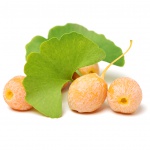 It is a dioecious tree, belonging to the Ginkgoaceae family. Commonly it is known by the name of ginkgo or tree of 40 shields. It is characterized by a slow growth, 15 cm the first year, 30 cm the second, reaching its normal height (13-17 m) at 30-40 years. The leaves are bilobed and greenish and adopt a bright yellow tone in autumn. It is in this season when the leaves fall practically all together. The fruit has a fleshy appearance and a yellow-green colour, and when it falls, it gives off a characteristic unpleasant odour. Ginkgo biloba is of Asian origin (China, Korea, Japan). It is the only representative of the Ginkgoaceaes family, for that reason its botanical classification was always difficult; responding to an intermediate type between Pteridophytes (ferns) and Conifers. This tree is very long-lived, it can live 1,000 years. Except in mountainous regions of eastern China, this tree is practically not cultivated.
It is a dioecious tree, belonging to the Ginkgoaceae family. Commonly it is known by the name of ginkgo or tree of 40 shields. It is characterized by a slow growth, 15 cm the first year, 30 cm the second, reaching its normal height (13-17 m) at 30-40 years. The leaves are bilobed and greenish and adopt a bright yellow tone in autumn. It is in this season when the leaves fall practically all together. The fruit has a fleshy appearance and a yellow-green colour, and when it falls, it gives off a characteristic unpleasant odour. Ginkgo biloba is of Asian origin (China, Korea, Japan). It is the only representative of the Ginkgoaceaes family, for that reason its botanical classification was always difficult; responding to an intermediate type between Pteridophytes (ferns) and Conifers. This tree is very long-lived, it can live 1,000 years. Except in mountainous regions of eastern China, this tree is practically not cultivated.
Ginkgo leaves contain basically two groups of compounds: flavonoids and terpenes (diterpenes and sesquiterpenes). These compounds are the main responsible for its therapeutic actions. The Gingko biloba has anti-inflammatory, vasoprotective and antioxidant properties, causing an improvement of the peripheral microcirculation.
